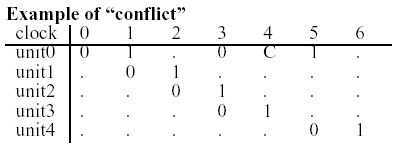题目描述
In this problem, a pipeline may have a feedback structure, that is, data paths among function units may have directed loops as shown in the next figure.

Since an arithmetic pipeline in this problem is designed as special purpose dedicated hardware, we assume that it accepts just a single sort of task. Therefore, the timing information of a pipeline is fully described by a simple table called a reservation table, which specifies the function units that are busy at each clock when a task is processed without overlapping execution.

In reservation tables, 'X' means "the function unit is busy at that clock" and '.' means "the function unit is not busy at that clock." In this case, once a task enters the pipeline, it is processed by unit0 at the first clock, by unit1 at the second clock, and so on. It takes seven clock cycles to perform a task.
Notice that no special hardware is provided to avoid simultaneous use of the same function unit. Therefore, a task must not be started if it would conflict with any tasks being processed. For instance, with the above reservation table, if two tasks, say task 0 and task 1, were started at clock 0 and clock 1, respectively,a conflict would occur on unit0 at clock 5. This means that you should not start two tasks with single cycle interval. This invalid schedule is depicted in the following process table, which is obtained by overlapping two copies of the reservation table with one being shifted to the right by 1 clock.

('0's and '1's in this table except those in the first row represent tasks 0 and 1, respectively, and 'C' means the conflict.)
Your job is to write a program that reports the minimum number of clock cycles in which the given pipeline can process 10 tasks.
输入
输出
样例输入 Copy
7
X...XX.
.X.....
..X....
...X...
......X
0
样例输出 Copy
34
提示

However, it takes only 34 clock cycles if each task is started at every third clock.

This is the best possible schedule and therefore your program should report 34 in this case.